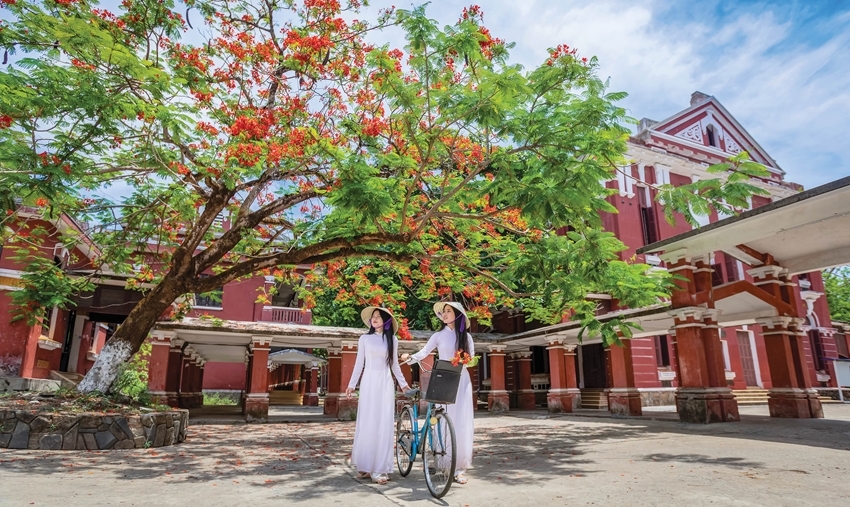 |
| Graceful girl students in Hue. Photo: Minh Thu |
At times when she was in a hurry, she wore her smoke-colored ao dai to the market. With just some buttons at the collar, the armhole, and the waist, she still looked decent. I liked watching my mother in her white silk ao dai making her hair in front of the mirror. I wished I would wear ao dai as she did when I grew up.
At that time, wherever I went, I saw women wearing ao dai. At markets or on streets, I often saw women in ao dai selling noodle soup, che (a sweet dish), tofu pudding, herbs, etc. Even those who sold coal or firewood wore ao dai. They tucked the flaps into the pants and rolled up their pants so that they could work and move quickly. Wearing ao dai to go out was conventional at the time.
Growing up, I went to Hue City to attend Dong Khanh High School. Dong Khanh was the biggest all-girl school in Central Vietnam, and studying there was the dream of generations of girl students. On the first school day, the city was filled with girls in white ao dai. Since becoming a student there, every time I came back to visit my native village, I heard people complimenting that I looked girly and graceful in ao dai.
At that time, raglan-sleeved ao dai was trendy. The flaps were shorter, suitable for us to walk or ride bicycles or motorbikes. Not only students at Dong Khanh, ones at Jeanne d’Arc wore white ao dai too while ones at Kieu Mau wore light blue. We were then too young to realize how beautiful the white ao dai was, but writers and artists all praised it with all their hearts.
Before that, Van Cao, a talented musician, visited the city and was tempted by ao dai. He then wrote, “Mot dem dan lanh tren song Hue/ Oi nho nhung hoai vat ao xanh!” (“Playing the musical instrument in a chilly night on Hue River/ How I miss forever the blue ao dai!”) Or poet Do Trung Quan wrote, “Whenever I go downtown seeing girl students scampering in ao dai, I have a lovesick feeling.”
Prof. Nguyen Ngoc Lan from Saigon called Le Loi White Street because it was filled with girl students from Dong Khanh in white ao dai every day at the time when they were dismissed from school. That “white waterfall” “softened” the hearts of so many visitors who came then left with regret.
Ao dai has been existed for centuries since the time when the talented artist Nguyen Cat Tuong designed his first LEMUR ao dai. It is a unique beauty for women and girls in 1934. In the 1960s, that graceful ao dai looked even nicer on girls with small hips. At that time, female movie stars such as Tham Thuy Hang, Kieu Chinh, Kim Cuong, etc., and famous singers such as Thai Thanh, Khanh Ly, Le Thu, etc., always wore ao dai on stage both in and out of the country. They looked very decent, charming, and very Vietnamese.
After the reunification, in an effort to heal the wounds of war, and despite achievements in economy, culture and society, unfortunately there was the time when ao dai was completely absent in Hue City. Ao dai were folded and stored in chests or wardrobes. Tens of years after that, ao dai made a gradual comeback. It was worn not only by girl students at Hai Ba Trung High School (i.e., former Dong Khanh High School) but also at airports, post-offices, banks, etc.
At ao dai shows at Hue Festivals from 2000 to 2014, the designers Minh Hanh, Si Hoang, Chu La (from Spain) and other fashion designers and director Quang Tu considered ao dai their source of inspiration. They sublimed Vietnamese ao dai and innovated it to suit the modern speedy era and to become timeless. They wanted to confirm that ao dai had been very Vietnamese fashion for women (and also for men) since ancient times and thereafter.
For many years now, on Mondays, I like walking on Nguyen Truong To and Le Loi streets to find myself again through the image of naive girl students with long black hair in ao dai to school and when they are dismissed.
Former girl students at Dong Khanh still wear ao dai to Gac Trinh, where the musician composed his timeless love songs. We go there to warm up the apartment, and to pay tribute to him with such music shows such as Goi ten bon mua. On those occasions, Prof. Buu Y, a writer, researcher, translator and Trinh Cong Son’s close friend is always present saying that he comes to enjoy Son’s songs and to look at people wearing ao dai.
In people’s eyes, Hue is more and more beautiful with many airy, clean, tree-lined streets. At times in the morning people can still see girl students in white ao dai and conical hats cycling to school. I hope more people will wear ao dai besides girl students and women at offices, and in everyday life so that Hue can be known as a “the Capital of Ao dai”. It will make the heritage city as soft as the Perfume River.